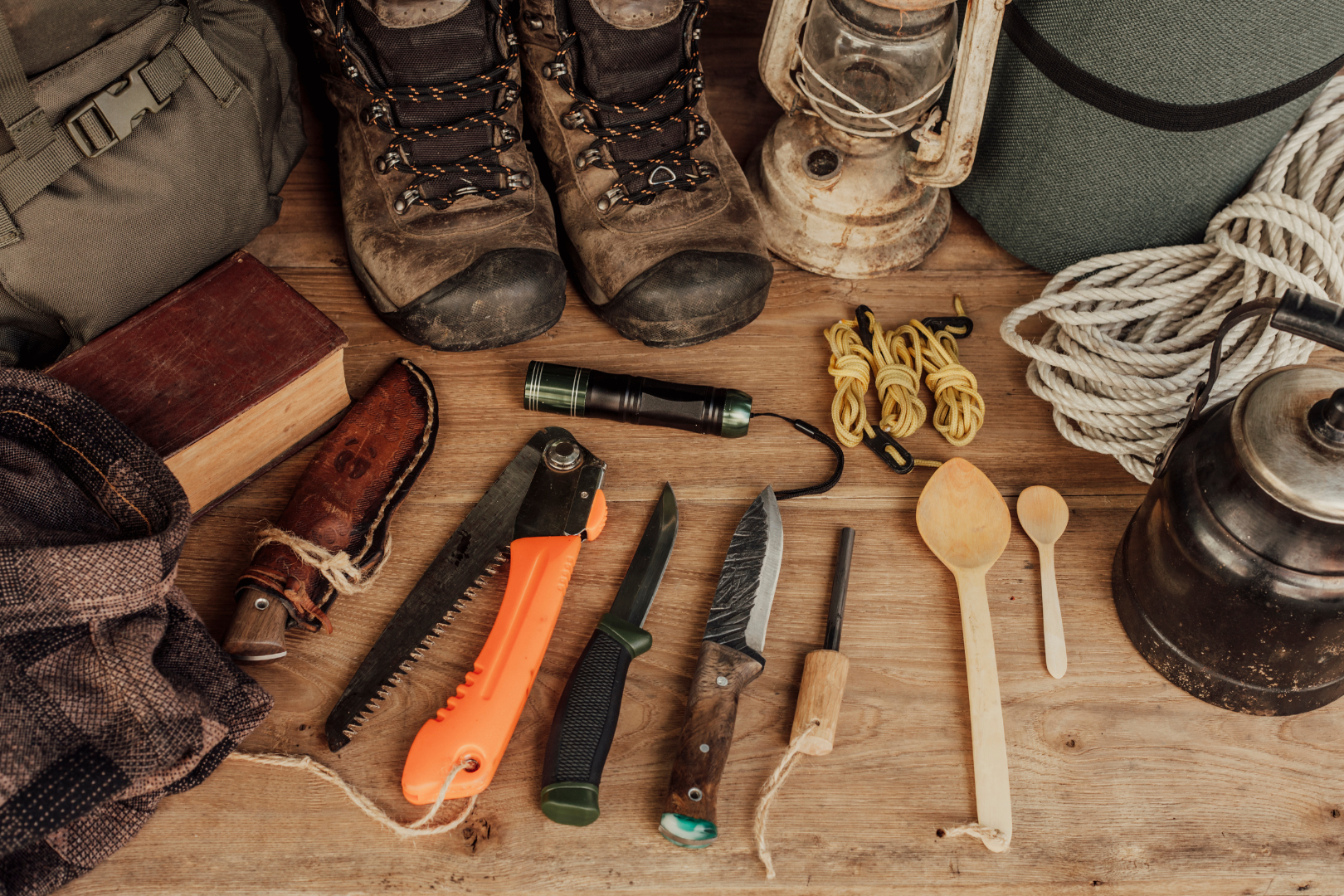Bushcraft camping is a type of camping that focuses on using wilderness survival skills and primitive camping techniques to thrive in nature. It emphasizes self-reliance in nature, minimal impact, and learning how to live comfortably in the woods using outdoor living skills. This involves mastering techniques like natural shelter building, fire starting methods, foraging edible plants, and navigating without technology. It’s about connecting with nature on a deeper level and developing sustainable camping practices.

Image Source: cdn.shopify.com
What Sets Bushcraft Apart from Traditional Camping?
Bushcraft and traditional camping both involve spending time outdoors, but their philosophies and approaches differ significantly.
| Feature | Traditional Camping | Bushcraft Camping |
|---|---|---|
| Focus | Comfort and convenience | Skill development and self-sufficiency |
| Gear | Modern, store-bought equipment | Minimal, often handmade or repurposed items |
| Impact | Can be higher, relying on established campsites | Lower, emphasizing minimal impact and “leave no trace” |
| Activities | Hiking, fishing, relaxing | Shelter building, fire making, foraging, crafting |
| Skillset | Basic camping skills | Advanced wilderness survival skills and outdoor living skills |
Essential Bushcraft Skills
To truly embrace bushcraft, you need to develop a core set of skills. These skills are not just about surviving; they’re about thriving and living comfortably in the woodland camping environment.
Natural Shelter Building
Creating a natural shelter building is one of the most crucial wilderness survival skills. It protects you from the elements, providing warmth, dryness, and security.
- Lean-to Shelter: A simple structure made by leaning branches against a fallen log or sturdy tree.
- Debris Hut: A more enclosed shelter built by piling up leaves, pine needles, and other natural materials over a frame.
- Wickiup: A dome-shaped shelter constructed from flexible branches and covered with bark, leaves, or other insulating materials.
When building a shelter, consider these factors:
- Location: Choose a site that’s protected from wind, rain, and potential hazards like falling trees.
- Materials: Use readily available, sustainable materials. Avoid damaging living trees unnecessarily.
- Size: Build a shelter that’s just big enough for your needs to conserve energy and resources.
- Insulation: Pack the shelter with insulating materials like leaves or moss to trap heat.
Fire Starting Methods
Fire is essential for warmth, cooking, signaling, and purifying water. Mastering fire starting methods is vital for any bushcrafter.
- Friction-Based Methods:
- Bow Drill: A traditional method using a bow to spin a spindle against a fireboard, creating friction and eventually an ember.
- Hand Drill: Similar to the bow drill, but using your hands to spin the spindle. This method is more challenging but requires less gear.
- Flint and Steel: Striking flint against steel to create sparks that ignite tinder.
- Fire Piston: A device that uses rapid compression to ignite tinder.
Tips for successful fire starting:
- Gather dry tinder: Use materials like birch bark, dry grass, pine needles, or cottonwood fluff.
- Collect various sizes of firewood: Start with small twigs and gradually add larger pieces as the fire grows.
- Protect your fire from wind and rain: Build a windbreak or choose a sheltered location.
- Never leave a fire unattended.
Foraging Edible Plants
Foraging edible plants can supplement your food supply and connect you with the natural world. However, it’s crucial to be absolutely certain about plant identification before consuming anything.
- Learn to identify common edible plants in your area: Use field guides, online resources, and experienced foragers to expand your knowledge.
- Be aware of poisonous plants: Many plants resemble edible ones, so be cautious and double-check your identification.
- Start with easy-to-identify plants: Berries, greens, and roots that have distinct characteristics are good starting points.
- Harvest sustainably: Only take what you need and avoid over-harvesting any particular plant.
Examples of Edible Plants:
| Plant | Edible Parts | Location |
|---|---|---|
| Dandelion | Leaves, flowers, roots | Common in lawns and fields |
| Cattail | Roots, shoots, pollen | Near water |
| Wild Onion | Bulbs, leaves | Fields and woodlands |
| Pine | Inner bark, needles (for tea) | Forests |
Navigating Without Technology
Relying on technology for navigation can be risky in the wilderness. Learning to navigate without technology is a critical wilderness survival skill.
- Using a Compass and Map: Learn how to read a topographic map and use a compass to determine your bearing and location.
- Natural Navigation:
- The Sun: The sun rises in the east and sets in the west.
- The Stars: The North Star (Polaris) is a reliable indicator of north in the Northern Hemisphere.
- Moss: Moss often grows more abundantly on the north side of trees.
- Wind: Prevailing winds can provide a general sense of direction.
Tips for navigation:
- Study maps of the area before you go.
- Pay attention to landmarks.
- Leave a detailed itinerary with someone you trust.
- Stay calm and avoid panicking if you get lost.
Water Procurement and Purification
Water is essential for survival. Knowing how to find and purify water is a must.
- Finding Water Sources: Look for streams, rivers, lakes, and springs. Collect rainwater or dew.
- Purification Methods:
- Boiling: The most reliable method. Boil water for at least one minute (three minutes at higher altitudes).
- Filtration: Use a portable water filter to remove sediment and bacteria.
- Solar Disinfection (SODIS): Expose clear water in a transparent plastic bottle to direct sunlight for at least six hours.
Essential Bushcraft Gear
While bushcraft emphasizes minimal gear, certain items can significantly enhance your experience and safety.
| Gear Item | Purpose |
|---|---|
| Knife | Cutting, carving, shelter building, fire preparation |
| Axe or Hatchet | Processing firewood, building shelters |
| Saw | Cutting larger branches and logs |
| Fire Starter | Ferro rod, lighter, matches (waterproof) |
| Container | Boiling water, carrying water |
| Cordage | Shelter building, traps, gear repair |
| First-Aid Kit | Treating injuries and illnesses |
| Map and Compass | Navigation |
| Sleeping Bag or Blanket | Insulation and warmth |
| Tarp | Shelter, ground cover |
Choose high-quality, durable gear that you can rely on. Learn how to use each item effectively before heading into the wilderness.
Fathoming Sustainable Camping Practices
Bushcraft is about respecting and preserving the natural environment. Practicing sustainable camping practices is crucial for minimizing your impact.
- Leave No Trace: Pack out everything you pack in, minimize campfire impacts, and avoid disturbing wildlife.
- Use Sustainable Materials: Gather firewood and building materials responsibly, avoiding damaging living trees and plants.
- Dispose of Waste Properly: Bury human waste in a cat hole at least 200 feet from water sources.
- Respect Wildlife: Observe animals from a distance and avoid feeding them.
- Minimize Fire Impacts: Use existing fire rings or create a temporary fire pit on mineral soil. Keep fires small and contained.
Examples of Bushcraft Projects
Bushcraft is not just about survival; it’s about using your skills to create useful items and improve your camp. Here are a few examples:
- Building a Bow Drill: Crafting a functional bow drill from natural materials.
- Making Cordage: Twisting plant fibers into strong rope.
- Carving a Spoon or Bowl: Using a knife to create eating utensils from wood.
- Building a Deadfall Trap: Constructing a simple trap for catching small game (where legal and ethical).
- Making a Natural Water Filter: Creating a filter from sand, charcoal, and gravel.
Ethical Considerations in Bushcraft
Bushcraft comes with ethical responsibilities. It’s crucial to approach the wilderness with respect and consideration for the environment and wildlife.
- Obey all local laws and regulations.
- Obtain necessary permits and licenses.
- Avoid trespassing on private property.
- Practice responsible hunting and fishing (where legal).
- Minimize your impact on the environment.
- Respect wildlife and avoid disturbing their habitat.
- Share your knowledge and skills responsibly.
Safety Precautions
Bushcraft can be challenging and potentially dangerous. Take these safety precautions to minimize risks:
- Tell someone where you’re going and when you expect to be back.
- Carry a first-aid kit and know how to use it.
- Be aware of weather conditions and potential hazards.
- Learn how to identify and avoid poisonous plants and animals.
- Stay hydrated and eat enough food.
- Avoid pushing yourself beyond your limits.
- Learn Basic wilderness survival skills** and attend a class taught by experts.
How to Get Started with Bushcraft
Starting with bushcraft can feel overwhelming, but with a gradual approach and dedication, anyone can learn the necessary skills.
- Start with the Basics: Focus on mastering the fundamental skills like fire starting, shelter building, and water procurement.
- Practice Regularly: Dedicate time to practice your skills in a safe and controlled environment.
- Take a Course: Consider taking a bushcraft or wilderness survival skills course from a qualified instructor.
- Read Books and Watch Videos: There are many excellent resources available to learn about bushcraft.
- Join a Community: Connect with other bushcrafters online or in person to share knowledge and experiences.
- Start Small: Begin with short trips and gradually increase the duration and difficulty as your skills improve.
Frequently Asked Questions (FAQ)
-
What is the difference between bushcraft and survival?
- Bushcraft is about living comfortably in nature using traditional skills and knowledge. Survival is about staying alive in a life-threatening situation. While there is overlap, bushcraft emphasizes thriving, while survival emphasizes immediate needs.
-
Can I practice bushcraft in a city park?
- It depends on the park’s regulations. Check with the local authorities before engaging in activities like fire starting or shelter building. Focus on skills like plant identification and knot tying in urban environments.
-
Who is bushcraft for?
- Bushcraft is for anyone who enjoys spending time in nature and wants to learn how to live more sustainably and self-sufficiently. It’s a rewarding activity for individuals, families, and groups of all ages and backgrounds.
-
What gear do I need to start bushcraft?
- A good knife, a fire starter, cordage, and a container for boiling water are essential starting points. You can gradually add more gear as your skills and needs evolve.
-
How do I learn to identify edible plants?
- Start with a reliable field guide and focus on learning a few common, easy-to-identify plants in your area. Attend workshops led by experienced foragers. Never consume a plant unless you are 100% certain of its identification.
Bushcraft camping is more than just a hobby; it’s a way of life. It’s about connecting with nature, developing self-reliance in nature, and living more sustainably. By learning the essential skills and embracing the ethical considerations, you can embark on a rewarding journey of outdoor living skills and self-discovery in the woodland camping environment.

Melody Smith is a passionate writer, outdoor enthusiast, and camping expert based in the Seattle Metropolitan Area. With a deep love for nature and adventure, she shares her personal experiences, tips, and insights on MyCampingPro.com. A seasoned camper and traveler, Melody combines her creative background in design and writing with her love for the great outdoors, offering practical advice and inspiring stories to help others make the most of their outdoor experiences. When she’s not exploring the wilderness, you can find her painting, collecting vintage treasures, or diving into a good book.
